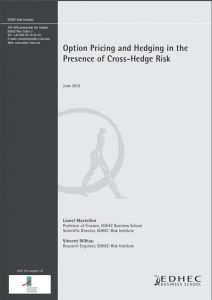

Option Pricing and Hedging in the Presence of Cross-Hedge Risk
This paper addresses the question of option pricing and hedging when the underlying asset is not available for dynamic trading, and some other asset is used as a substitute. It first provides an overview of the various hedging methodologies that can be used in this incomplete market setting, distinguishing between self-financing and non-self-financing strategies. Focussing on a local risk-minimization criterion, it presents an analytical expression for the optimal hedging strategy and the corresponding option price. It also provides a quantitative measure of the residual risk over the life of the option.
Author(s):
Summary:
This paper addresses the question of option pricing and hedging when the underlying asset is not available for dynamic trading, and some other asset is used as a substitute. It first provides an overview of the various hedging methodologies that can be used in this incomplete market setting, distinguishing between self-financing and non-self-financing strategies. Focussing on a local risk-minimization criterion, it presents an analytical expression for the optimal hedging strategy and the corresponding option price. It also provides a quantitative measure of the residual risk over the life of the option.
Register to download PDF
Register/Log in| Type : | Working paper |
|---|---|
| Date : | 14/06/2010 |
| Keywords : |
Asset Pricing |

